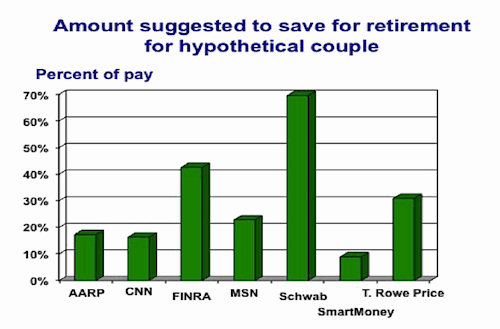The retirement financing challenge is a worldwide phenomenon. Almost every advanced nation has its Boomer generation, its massive debt and its rising retiree-to-worker ratio. Many emerging nations have no safety net at all for their aged. Governments, companies, families and individuals from Singapore to Honduras, from Germany to Australia, all feel the pain.
Not surprisingly, the search for solutions to this complex demographic, political and financial problem has elicited a river of academic research. Each year, social scientists use the latest survey techniques and mathematical models to illuminate different aspects of the problem and to test potential solutions.
For the second consecutive year, Retirement Income Journal is honored to bring some of the leading English-language research in this area to your attention. We asked researchers to identify their favorites among the research that they first read during 2012 (even it did not appear in published form until 2013). They recommended the 16 research papers that we describe below (with some links to webpages or pdfs).
Here you’ll find research that emanates from Croatia, Denmark and Germany, in addition to the U.S. There’s research from at least 20 different universities. There are papers that apply to advisors of individual clients and to sponsors of institutional retirement plans. There’s research for annuity issuers and for distributors of annuity products. At least one paper calls for a major change to U.S. retirement policy. As a group, the papers shed light on many of retirement financial challenges that individuals, financial services providers, and governments face today.
A Utility-Based Approach to Evaluating Investment Strategies
Joseph A. Tomlinson, Journal of Financial Planning, February 2012.
In exploring the often-overlooked “utility” or insurance value of annuities, this actuary and financial planner ventures where few others care to tread. He rejects the popular notion that an annuity represents a gamble with death. “Immediate annuities are often viewed as producing losses for those who die early and gains for those who live a long time, whereas I am portraying no gain or loss regardless of the length of life,” he writes. “This is an issue of framing or context. If one thinks of an annuity as providing income to meet basic living expenses, both the income and the expenses will end at death.” He also asked 36 people how much upside potential they would require—i.e., how much surplus wealth at death—to justify a retirement investment strategy that carried a 50/50 risk of depleting their savings two years before they died.
Spending Flexibility and Safe Withdrawal Rates
Michael Finke, Texas Tech University; Wade D. Pfau, American College; and Duncan Williams, Texas Tech. Journal of Financial Planning, March 2012.
The “4% rule” is a needlessly expensive way to self-insure against longevity risk, this paper suggests. “By emphasizing a portfolio’s ability to withstand a 30- or 40-year retirement, we ignore the fact that at age 65 the probability of either spouse being alive by age 95 is only 18%. If we strive for a 90% confidence level that the portfolio will provide a constant real income stream for at least 30 years, we are planning for an eventuality that is only likely to occur 1.8% of the time,” they write. They also show that a mixture of guaranteed income sources and equities burns hotter and more efficiently than a portfolio of stocks and bonds: “The optimal retirement portfolio allocation to stock increases by between 10 and 30 percentage points and the optimal withdrawal rate increases by between 1 and 2 percentage points for clients with a guaranteed income of $60,000 instead of $20,000.”
Should You Buy an Annuity from Social Security?
Steven A. Sass, Center for Retirement Research at Boston College, Research Brief, May 2012.
In a financial version of “The Charlie’s Angels Effect,” Social Security went from misbegotten child to Miss USA last year. Returns on low-risk investments were lower than the step-up in Social Security income that comes from postponing benefits to age 66 or even 70. It thus made more sense for a 62-year-old retiree to delay Social Security and consume personal savings than to hoard his own cash and claim Social Security benefits. “Consider a retiree who could claim $12,000 a year at age 65 and $12,860 at age 66—$860 more,” the author writes. “If he delays claiming for a year and uses $12,860 from savings to pay the bills that year, $12,860 is the price of the extra $860 annuity income. The annuity rate—the additional annuity income as a percent of the purchase price—would be 6.7% ($860/$12,860).”
Lifecycle Portfolio Choice with Systematic Longevity Risk and Variable Investment-linked Deferred Annuities
Raimond Maurer, Goethe University; Olivia S. Mitchell, The Wharton School, University of Pennsylvania; Ralph Rogalla, Goethe University; Vasily Kartashov, Goethe University. Research Dialogue, Issue 104, June 2012. TIAA-CREF Institute.
Deferred income annuities—often purchased long before retirement—are in vogue. To offset the risk that a medical breakthrough could lift average life expectancies, annuity issuers could raise prices. But that would suppress demand. The authors of this study propose a “variable investment-linked deferred annuity” (VILDA) that might solve that problem. The owner would assume the risk of rising average life expectancy by agreeing to a downward adjustment in the payout rate should average life expectancy rise. In return, he would enjoy a lower initial price. Access to such a product, perhaps through a 401(k) plan, could increase the annuity owner’s income at age 80 by as much as 16%, the researchers believe.
Retirement Income for the Financial Well and Unwell
Meir Statman, Santa Clara University and Tilburg University, Summer 2012.
In this paper, the author of What Investors Really Want calls for a mandatory, universal workplace-based defined contribution plan in the U.S. that would make Americans less dependent on Social Security for retirement income. “It is time to switch from libertarian-paternalistic nudges to fully paternalistic shoves,” the author writes. He argues that automatic enrollment, which has been shown to increase 401(k) participation, is not strong enough a measure to make a difference in the amount of retirement savings available to most people. He recommends tax-deferred private savings accounts similar to 401(k) and IRA accounts but mandatory and inaccessible to account owners before they reach retirement age.
Harmonizing the Regulation of Financial Advisers
Arthur B. Laby, Rutgers University. Pension Research Council Working Paper, August 2012.
In this paper, a law professor analyzes the debate over harmonized standards of conduct for advisors. On the problem of principal trading, he writes, “Any broker-dealer that provides advice should be required to act in the best interest of the client to whom the advice is given [but] imposing a fiduciary duty on dealers is inconsistent, or not completely consistent, with the dealer’s role. A dealer’s profit is earned to the detriment of his trading partner, the very person to whom the dealer would owe a fiduciary obligation.” He identifies three obstacles to harmonization: the difficulty of analyzing its costs and benefits, the presence of multiple regulators, and the question of whether advisors should have their own self-regulatory organization.
A Framework for Finding an Appropriate Retirement Income Strategy
Manish Malhotra, Income Discovery. Journal of Financial Planning, August 2012.
No two retirees have exactly the same needs, and advisors need a process for finding the best income strategy for each client. The author has created a framework that advisors can use to tackle this challenge. His framework includes two “reward metrics” (income and legacy) and three “risk metrics” (probability of success, the potential magnitude of failure, and the percentage of retirement income safe from investment risk). “Using this framework, advisers can incorporate a variety of income-producing strategies and products, and decisions about Social Security benefits, into their withdrawal analyses—lacking in much of the past research focused purely on withdrawals from a total return portfolio,” Malhotra writes.
An Efficient Frontier for Retirement Income
Wade Pfau, Ph.D. September 2012 (Published as “A Broader Framework for Determining an Efficient Frontier for Retirement Income.” Journal of Financial Planning, February 2013.
Just as there’s an efficient frontier for allocation to risky assets during the accumulation stage, so there’s an efficient frontier for allocation to combinations of risky assets and guaranteed income products in retirement, this author proposes. He describes “various combinations of asset classes and financial products, which maximize the reserve of financial assets for a given percentage of spending goals reached, or which maximizes the percentage of spending goals reached for a given reserve of financial assets” and asserts that “clients can select one of the points on the frontier reflecting their personal preferences about the tradeoff between meeting spending goals and maintaining sufficient financial reserves.”
How Important Is Asset Allocation To Americans’ Financial Retirement Security?
Alicia H. Munnell, Natalia Orlova and Anthony Webb. Pension Research Council Working Paper, September 2012.
Asset allocation may be important when it comes to building a portfolio, but “other levers may be more important for most households,” according to this paper. “Financial advisers would likely be of greater help to their clients if they focused on a broad array of tools—including working longer, controlling spending and taking out a reverse mortgage,” the authors write, claiming that decisions in these areas can have a bigger impact on retirement savings than merely transitioning from a typical conservative portfolio to an optimal portfolio. “The net benefits of portfolio reallocation for typical households would be modest, compared to other levers,” they write. “Higher income households may have slightly more to gain.”
The Revenue Demands of Public Employee Pension Promises
Robert Novy-Marx, University of Rochester; Joshua D. Rauh, Stanford. NBER Working Paper, October 2012.
The cost of fully funding pension promises to state and local government workers is startlingly large, according to these authors. Assuming that pension assets earn only a risk-free real return of 1.7% (the yield of TIPS in 2010) and that each state’s economy grows at its 10-year average, government contributions to state and local pension systems would have to rise to 14.1% of own-revenue to achieve fully funded systems in 30 years, the authors say, or $1,385 per household per year. “In twelve states, the necessary immediate increase is more than $1,500 per household per year, and in five states it is at least $2,000 per household per year,” they calculate, adding that a switch to defined contribution plans would cut the pension burden dramatically.
What Makes Annuitization More Appealing?
John Beshears, Stanford; James J. Choi, Yale; David Laibson, Harvard; Brigitte C. Madrian, Harvard; and Stephen P. Zeldes, Columbia. NBER Working Paper, November 2012.
When offered an annuity or a lump sum at retirement, many defined benefit plan participants choose the lump sum. While this behavior obeys the principle that “a bird in the hand is worth two in the bush,” it can be shortsighted for healthy people who need to finance a long retirement. How can policymakers help cure this form of myopia? These researchers surveyed DB plan participants and found them more willing to choose annuitization if they could annuitize part of their savings instead of 100%, if their annuity income were inflation-adjusted, and if they could receive an enhanced payment once a year, in a month of their own choosing, rather than identical amounts every month.
Home Equity in Retirement
Makoto Nakajima, Federal Reserve Bank of Philadelphia; Irina A. Telyukova, University of California, San Diego. December 2012.
The retirement savings crisis notwithstanding, many older Americans reach the end of their lives with too much unspent wealth, rather than too little. Some academics call it “the retirement savings puzzle.” The authors of this study think they’ve solved the mystery. Much of the unspent wealth is home equity, they believe. “Without considering home ownership, retirees’ net worth would be 28% to 53% lower,” they write. A number of homeowners tap their home equity by downsizing, purchasing reverse mortgages or simply neglecting to invest in home maintenance as they get older. But retired homeowners rarely downsize unless an illness or death of a spouse occurs, the study says.
Active vs. Passive Decisions and Crowd-Out Retirement Savings Accounts: Evidence from Denmark
Raj Chetty, Harvard University and NBER; John N. Friedman, Harvard University and NBER; Soren Leth-Petersen, University of Copenhagen and SFI; Torben Heien Nielsen, The Danish National Centre for Social Research; Tore Olsen, University of Copenhagen and CAM. National Bureau of Economic Research, December 2012.
Are tax subsidies the best way to encourage retirement savings? Not in Denmark, say these authors. “Each [dollar] of tax expenditure on subsidies increases total saving by one [cent],” they write, because 85% of Danish retirement plan participants are “passive savers” who ignore tax subsidies. If employers simply put more money into retirement plan participants’ accounts, it would do much more to raise retirement readiness, the authors assert, finding that every additional [dollar] added by employers enhances savings by 85 cents. Though their study is based on Danish data and Danish currency, the authors suggest that the results cast doubt on the effectiveness of America’s $100-billion-a-year tax expenditure on retirement savings.
Wealth Effects Revisited: 1975-2012
Karl E. Case, Wellesley College; John M. Quigley, University of California, Berkeley; Robert J. Shiller, Yale University. NBER Working Paper Series, January 2013.
Changes in housing wealth have a much bigger effect on consumption than changes in stock market wealth, the authors assert. During the housing boom of 2001-2005, the value of real estate owned by households rose by about $10 trillion, and “an average of just under $700 billion of equity was extracted each year by home equity loans, cash-out refinance and second mortgages,” the authors write. In 2006-2009, real estate lost $6 trillion in value, reducing consumption by about $350 billion a year. “Consider the effects of the decline in housing production from 2.3 million units to 600,000, at $150,000 each. This implies reduced spending on residential capital of about $255 billion,” they note. The paper builds on a 2005 paper by these authors, which remains the most downloaded article on the B.E. Journal of Macroeconomics website.
Optimal Initiation of a GLWB in a Variable Annuity: No Arbitrage Approach
Huang Huaxiong, Moshe A. Milevsky and Tom S. Salisbury, York University. February 2013.
Most owners of variable annuities with in-the-money guaranteed lifetime withdrawal benefits (GLWBs) should activate their contract’s optional income stream sooner-rather-than-later and later-rather-than-never, these authors recommend. “The sooner that account can be ‘ruined’ [reduced to a zero balance] and these insurance fees can be stopped, the worse it is for the insurance company and the better it is for the annuitant,” they write, noting that even the presence of a deferral bonus or “roll-up” feature in the product doesn’t justify postponing drawdown. With over $1 trillion in GLWB contracts in force, the paper suggests, the behavior of contract owners will have major implications for them and for the annuity issuers.
Empirical Determinants of Intertemporal Choice
Jeffrey R. Brown, University of Illinois at Urbana-Champaign; Zoran Ivkovic, Michigan State University; Scott Weisbenner, University of Illinois at Urbana-Champaign. NBER Working Paper, February 2013).
Croatia’s bloody war of independence from Yugoslavia in the 1990s yielded a natural experiment in behavioral finance. To save money from 1993 to 1998, the Croatian government began indexing pensions to prices instead of wages. After the war, the courts ordered the government to reimburse pensioners for the reduction. In 2005, about 430,000 Croatians were offered either four semi-annual payments—totaling 50% of the nominal amount owed—or six annual payments—totaling 100% of the nominal amount owed. Seventy-one percent chose the first option. “As one might expect,” the authors write, “those with higher income and wealth were more willing to accept deferred payment from the government.”
© 2013 RIJ Publishing LLC. All rights reserved.





